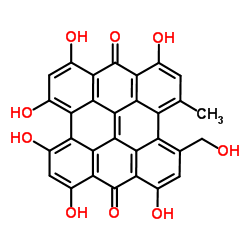Inhibition of 17β-estradiol activation by CYP1A1: genotype- and regioselective inhibition by St. John's Wort and several natural polyphenols.
Dieter Schwarz, Pyotr Kisselev, Wolf-Hagen Schunck, Ivar Roots
Index: Biochim. Biophys. Acta 1814(1) , 168-74, (2011)
Full Text: HTML
Abstract
Several epidemiological studies associate certain CYP1A1 genotypes, alone or in combination, with an increased risk of estrogen-related cancers. Previously we demonstrated that metabolic activation of estrogens by CYP1A1 is a genotype-dependent reaction with the CYP1A1.2 (Ile462Val) variant being the most efficient catalyst (Kisselev et al.). To answer the question whether genotype-dependent inhibition of activation of estrogens by CYP1A1 could also contribute, we studied the inhibition of hydroxylation activity of the most common allelic variants of human CYP1A1 towards 17β-estradiol. We expressed and purified CYP1A1.1 (wild-type), CYP1A1.2 (Ile462Val), and CYP1A1.4 (Thr461Asn) and performed inhibition assays by natural polyphenols of our diet and drugs of NADPH-dependent estradiol hydroxylation in reconstituted CYP1A1 systems. From the polyphenols studied, a St. John's Wort (Hypericum perforatum) extract, some of its main single constituents hypericin, pseudohypericin, and quercetin, as well as the flavonols kaempferol, myricetin and the phytoestrogens resveratrol and tetramethyl-stilbene exhibited strong inhibition. For the St. John's Wort extract and its single constituents hypericin, pseudohypericin, and quercetin, inhibition exhibited a remarkable dependency on the CYP1A1 genotype. Whereas (wild-type) CYP1A1.1 was most inhibited by the whole crude extract, the variant CYP1A1.2 (Ile462Val) was significantly stronger inhibited by the constituents in its pure form: IC₅₀ values for 2-hydroxylation was more than two times lower compared with the wild-type enzyme and the variant CYP1A1.4 (Thr461Asn). Besides this, the inhibition exhibited a remarkable regioselectivity. The data suggest that risk of estrogen-mediated diseases might be not only influenced by CYP1A1 genotype-dependent activation but also its inhibition by natural polyphenols of our diet and drugs.Copyright © 2010 Elsevier B.V. All rights reserved.
Related Compounds
| Structure | Name/CAS No. | Molecular Formula | Articles |
|---|---|---|---|
 |
Pseudohypericin
CAS:55954-61-5 |
C30H16O9 |
|
Hypericum perforatum: pharmacokinetic, mechanism of action, ...
2014-05-01 [Phytother Res. 28(5) , 643-55, (2014)] |
|
The main components of St John's Wort inhibit low-density li...
2007-02-01 [Free Radic. Res. 41(2) , 234-41, (2007)] |
|
Rapid and efficient purification of naphthodianthrones from ...
2009-05-01 [J. Sep. Sci. 32(9) , 1374-82, (2009)] |
|
Variation of hypericins in Hypericum triquetrifolium Turra g...
2008-12-01 [Nat. Prod. Res. 22(18) , 1597-604, (2008)] |
|
In vitro photochemical and phototoxicological characterizati...
2011-10-01 [Phytochemistry 72(14-15) , 1814-20, (2011)] |